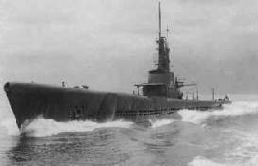USS ARCHERFISH (SS 311)
Joe Kronzer
Joe Kronzer relates the vivid details of a near disaster in his first sub.

"I imagine every submariner has experienced a sudden, dire situation where he and his boat came close to becoming one of those “failed to return and presumed lost” statistics. I was assigned to the USS ARCHERFISH (SS 311) following sub school, and stationed in Key West. During the underway portion of my getting qualified we were operating submerged in deep water off of Key West.
I was Diving Officer in the control room while Les Banghart was the Conning Officer in the conning tower. The conning tower sits just above the control room, and the Conning Officer can look down through the lower conning tower hatch at the Diving Officer directly below. As Diving Officer, I was responsible to keep the boat at ordered depth and. properly trimmed. As Conning Officer, Les had tactical responsibility, including safe navigation and maneuvering of the boat.
During this particular dive, my performance was being observed by the Captain. Upon submerging, I had trimmed the boat at periscope depth (60 feet keel depth), then was ordered to take the boat to 200 feet. (Note: I should explain here that we had two depth gauges – one used above 165 feet called the shallow gauge and a deep depth gauge that measured deeper depths. When going below 165 feet, we shut off the shallow depth gauge and would tell depth by the deep depth gauge.) As we approached 160 feet, I gave the order to “secure the shallow gauge.” The sailor who controlled the bow planes was responsible for securing the shallow gauge. To do this he had to reach behind the diving control panel and, by feel, find the correct valve to turn clockwise to the shut position. Now, there were several valves behind the control panel and, by mistake, the sailor grasped and shut the “master stop valve” that shut off both the shallow and deep depth gauges. This occurred at the same time I was leveling the boat off to settle at my 200 foot ordered depth. With the depth gauges master valve shut, the deep gauge was no longer registering a depth reading beyond the depth we were at when the master valve was shut. This happened to be 195 feet, the depth at which the deep depth gauge was stuck on.
So there I was with the depth gauge telling us we were at 195 feet when my ordered depth was 200 feet, and the Captain standing right behind me observing my skill (or lack thereof) as Diving Officer. Neither the Captain nor I realized that our depth gauge was erroneously stuck at 195 feet. He then asked, “Mr. Kronzer, what is your ordered depth?” to which I replied: “200 feet, sir” to which the Captain replied: “Well, then, get us down to ordered depth!”
I began taking the depth-keeping steps I learned at sub school. First, I ordered a steeper down angle on the boat. Nothing happened, the gauge still read 195 feet. Next I ordered a bit more speed. Still nothing happened. At this point I felt that the boat had become lighter due to a change in water temperature. So I began flooding water into our trim tanks to make the boat heavier.
Now here’s where the frightening part of this story comes in. Remember, that the Captain was standing directly behind me and both of us were focused on the control room depth gauge while I was attempting (erroneously) to get the boat to descend to 200 feet. Les was looking down at us from the conning tower while observing his own conning tower depth gauge which was reading depth correctly. Although Les was watching us go deeper than 200 feet and continue to pass 300 feet, he did not say anything believing that, with the Captain standing behind me, everything must be OK. Finally, as we were heading down past 400 feet, Les Banghart called down to us saying “Sir, you know, we’re passing test depth”. (Note: A submarine has two warning depths: “Test” depth and “Crush” depth. At crush depth sea pressure will cause the hull to implode. Test depth is well above crush depth, and a submarine can safely operate at or above test depth. (Test depth for the USS ARCHERFISH was 412 feet and crush depth was 600 feet).
Upon hearing Les yell down to us: “Sir, you know, we’re passing test…” I immediately ordered full rise on the planes, all back full and the blowing of all main ballast tanks. At about that time, flooding reports came in from the Forward Torpedo Room and the Maneuvering Room back aft. Fortunately, the sailors knew exactly what to do and brought the flooding under control before we took on too much water. We were able to level off the boat and get to the surface without further trouble.
Although happy we got out of this, I was sure I would soon get orders to the closest surface ship. However, my good Captain never said a word to me or shipped me off to "await further orders." When we further analyzed what happened, we figured that we were at or below our crush depth by the time we were able to stop our decent and head to the surface. Thank God for the Portsmouth Naval Shipyard submarine designers and builders. I still shudder today when I think about this event in my life. I almost left my dear Carole ("Cully") a widow.
Whew! Joe Kronzer
